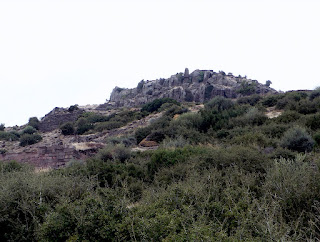Assos (now called Behramkale) was a small Ionian city on the coast of what is now Turkey and looks from its steep perch across the Aegean to Lesbos six nautical miles away.
 |
| Lesbos glimpsed across the gulf from Assos. |
It has an ancient history - it was mentioned by Homer in the Illiad; Aristotle set up school here at the gymnasium and married a local woman. The site has a marvellous Hellenistic theatre able to seat 6,000 or so.
 |
| Hellenistic theatre: "Get you wolf-nipple chips here, they're great" |
Plato visited and St Paul and St Luke met each other in Assos (as mentioned in the Acts of the Apostles) before setting off together to evangelize on Lesbos and elsewhere.
 |
| The ancient road to the port: St Luke and St Peter would have walked here. |
 |
| Olives: near Assos |
The city itself appears to have been first settled in the seventh century BC and became a thriving port on what was then called Troad (now Biga) peninsular.
The city has been in turn, Greek, Roman, Byzantine, Ottoman and now Turkish. In the aftermath of the Turkish war of independence (1920's) the Greek speaking population of Assos were forcibly exchanged with the Turkish speaking population of Lesbos. The port remained busy until the nineteen seventies when, after the Turkish invasion of Cyprus it became impossible (for a decade or two) for the populations in Lesbos and Assos to visit each other. Thankfully, those tensions have eased somewhat but the port is used for a little fishing and as a tourist port.
 |
| Assos: Now a quiet port. |
We climbed up from our hotel situated on the harbour, along cow tracks and goat paths. Along the way, we pushed our way through thickets of your oak trees and up over lichen covered boulders set in random collections of terracotta potsherds from the ancient city.
Grasshoppers, scarab beetles, large snails and huge centipedes were everywhere and wild thyme and other herbs grew between the rocks. We gradually worked our way upwards, at our backs lay the Aegean sea and Lesbos - a darker blue coloured cloud amidst the grey of the sea and sheets of stratus clouds to our south.
 |
| A "python" amidst the potsherds. |
Finally, we gained our goal - the middle part of the ancient city: The theatre, the stoa and the forum.
We walked about the ruins of Assos - with the exception of the theatre a lot of historical imagination is required to make out what it would have been like. However, large parts of the city gates and walls are still standing and the road out of the city is in excellent condition.
 |
| The road out of Assos |
 |
| Another view of the theatre |
 |
| The acropolis lowers above the middle city |
The acropolis lowers over the city - the ruins of a temple of Athena stand there.
And parts of the gymnasium and stoa where Aristotle taught are still standing too.
Ceylan (our guide) spins magnificent yarns - she is our Scheherezade - and dead rock and dumb walls come alive with the touch of her voice.
 |
Our guide: Ceylan Tuna.
|
We were fortunate too, in that the archaeologists had not yet finished their dig for the season. We came across them (one archaeologist and three workman) as we were walking out of the site.
 |
| Wheel-barrow, theodolite and tourists - the reality of archaeology in Turkey. |
Here's a picture of the tools of the trade: pick, bucket and sieve:
 |
| Tools of the trade: bucket, pick and sieve. |
We walked through the ancient gates of the city and by the necropolis outside its walls and thence back down the antique road to the modern town clustered around the harbour.
 |
| The gates of Assos |
 |
| A Roman sarcophagus in Assos's necropolis. |
 |
| Back to "neo"-Assos |
Nothing stays the same, but everything - though broken - still remains in Assos.
















Comments
Post a Comment